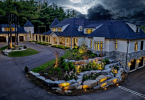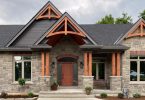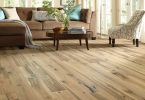Text by Pat Gerbrandt
Even though the New Year has begun, and several winter months are already behind us, the appeal of a fireplace beckons warmly.
A fireplace can be incorporated into renovation plans almost as easily as those for a new house.
If you are considering a wood burning fireplace, remember to plan also for wood storage. If an indoor wood box with easy access to the storage area is feasible, you’ll save many steps. Not all plans will allow for that, but perhaps there can still be thoughtful placement to minimize the distance you’ll be carrying the fuel. You’ll need about 18” clearance from the face of the fireplace.
Fireplaces are vented to the outside through 4” corrugated ventilation pipe that is led behind the chimney chase through to the exterior. The chase will be framed out with wood then sheeted with whatever material you choose – drywall or cement board or plywood that requires a scratch coat.
Fireplace location is not restricted to living or family rooms. You might also like to have your fireplace in a dining area, eat-in kitchen, office/den, or in the master bedroom. A two-sided fireplace can enhance adjacent rooms. A fireplace can even be part of a spa package, tucked into the same room as a jetted tub or Jacuzzi. Usually though, fireplaces are used in great rooms because the added heat is so welcome in larger spaces. Generally, a wood burning fireplace should be in a room no smaller than 10’ x 12’. A gas fireplace takes less space than a wood burning one – three square feet is adequate.
Those who have any experience relying upon firewood for heating fuel know that there is some work involved. If you don’t want to pay for firewood, you’ll have to cut it yourself, stack it, and carry out the ashes. Fire building skills are a distinct asset, and being able to judge the quality of firewood can prevent disappointment. On the other hand, with a gas fireplace, you get heat at the flick of a switch. John Klassen of JEK says that natural gas fireplaces offer another distinct advantage because, “Gas is cleaner,” but concedes that a wood burning fireplace has its own appeal. “I still think there should be an air freshener that smells like a wood fire.”
Cultured stone, a popular choice for fireplaces these days, is applied right to the wall and it doesn’t add weight to house. This manmade stone is most popular because it is so versatile. A wide range of colors allows building owners to have free reign in design, and to use it in various applications so that the fireplace look can carry through a theme.
The most popular colors are the neutral earth tones – creams, beiges, browns and taupes, which work well with hardwood floors and darker paint colors. The cleaner lines of cultured stone are a little more elegant than fieldstone, and less angular than traditional brick. The wide range of choices available for fireplace construction enhances the appeal of this feature for your home.
Latest posts by Canadian Home Trends (see all)
- Dining Room Design Tips - December 2, 2025
- Practical Luxury in Forest Grove - December 2, 2025
- The Hidden Value of Great Design - December 2, 2025






